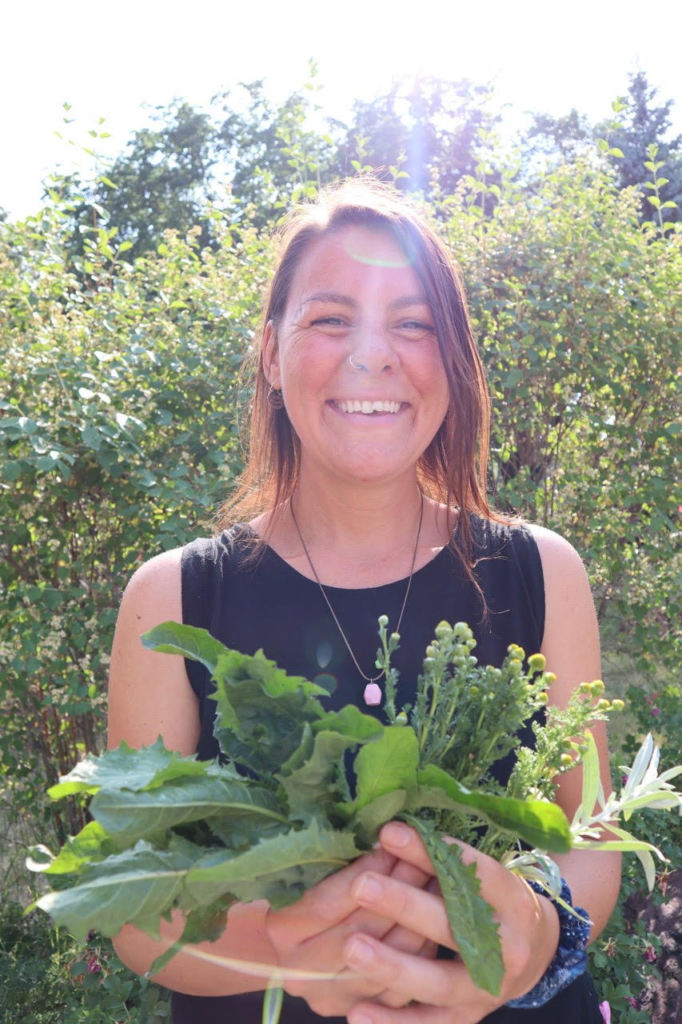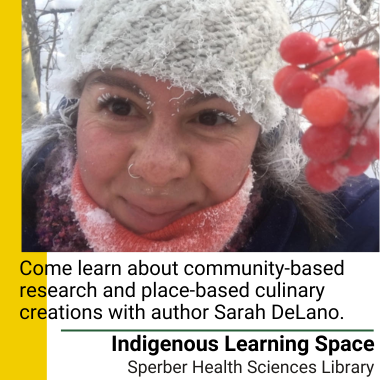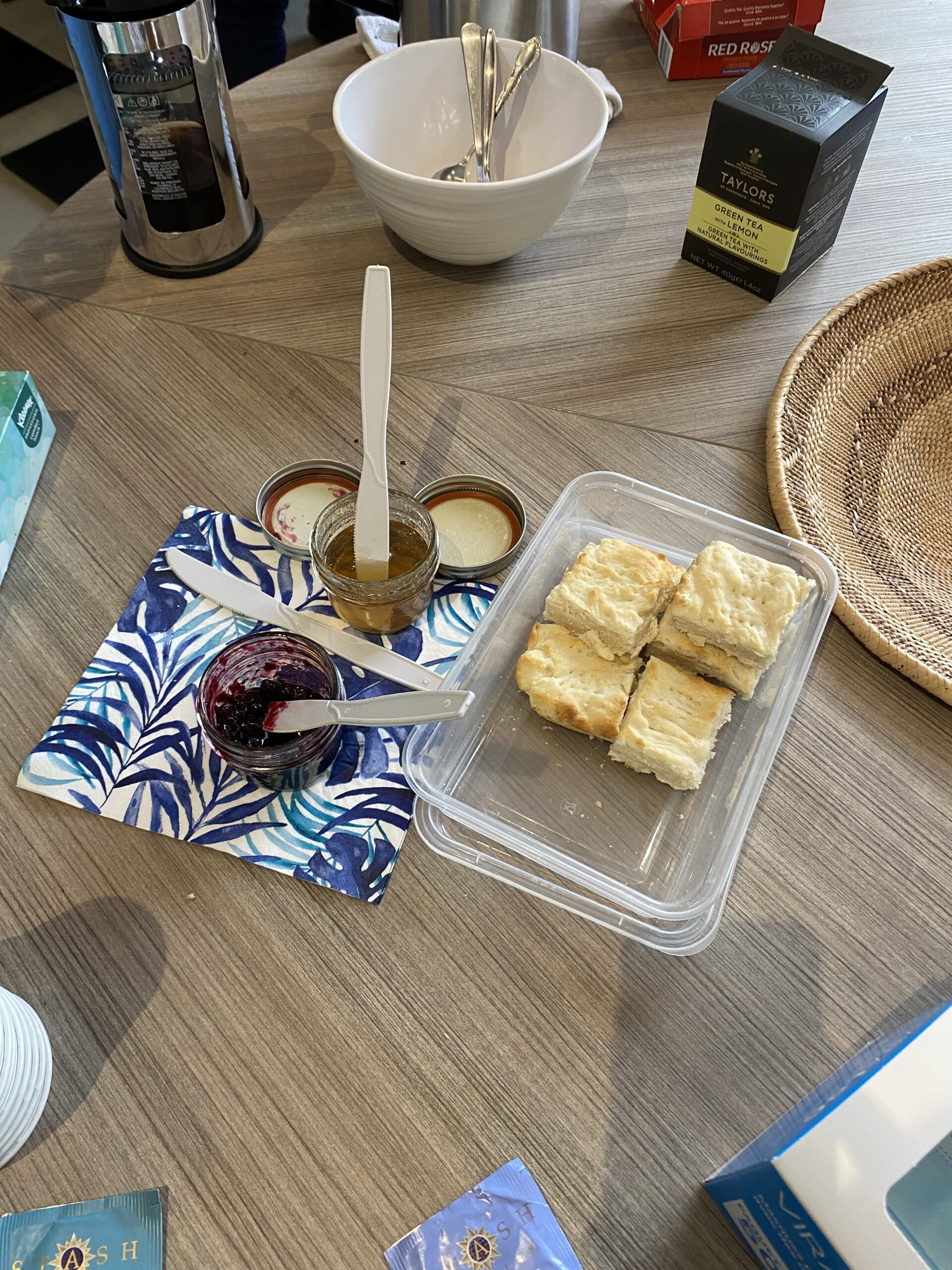Report by J. Kaur
The only time I remember eating bannock was at an elementary school field trip to Fort Edmonton Park.

photo North Saskatchewan River
Valley Conservation Society
We had made it ourselves and I can promise you that bannock made by elementary school hands is barely edible. But when it’s made by someone else, I realized I enjoyed the taste of firm but soft bannock with sweet dandelion jam spread on top. I’m usually a picky eater but I think dandelion jam might be even better than strawberry.
I was enjoying this food at a talk by Sarah DeLano about her community-based research project and the place-based recipe book that came from her collaboration with 10 other women called Rat Routes and Reasons to Gather. DeLano is Métis, with ties to the Rat Creek Ravine, and a Director of the North Saskatchewan River Valley Conservation Society. She has a wide range of knowledge of gathering and harvesting plants and berries from local places in Edmonton.
The talk took place at the Indigenous Learning Space, which I eventually found in a corner of the Sperber Library at the Edmonton Clinic Health Academy at the University of Alberta. The Indigenous Learning Space is a small room with translucent windows, allowing students sitting in the library to look in. Despite being small, it’s a comfortable room with an assortment of chairs and couches and a large screen up on one wall.
When I walked in, I was greeted warmly and directed to the table to taste the food, which was made by DeLano using ingredients gathered here in Edmonton. As we settled into our seats, hands busy with the jam spread bannock and cups of hot tea, DeLano suggested everyone in the room introduce themselves.
There were 14 of us, making the room feel comfortably occupied, and all of us were women. I was intrigued by the range of ages and the diversity in culture and profession. There were guests who were simply interested in learning more about plants and gathering or those who wanted to hear from an Indigenous perspective. Another guest mentioned her Métis background and there was a moment of ooh, I think we might be family. There were a few students like me; someone studying Indigenous literature and someone else working on their graduate degree.
I was expecting we would be learning about the Indigenous ways of berry picking and gathering in local areas. While there was some information about that, the focus of the presentation was about the community work that DeLano was involved in at the Multicultural Family Resource Society in the McCauley area. About 13 years ago, she had decided to teach a class of women who were attending with their small babies about green spaces within the community, like parks and ravines, as well as teaching them about picking berries.

It was the other women in the Society who were curious about using these local foods to cook. Though DeLano talked about her lack of cooking expertise, she was able to teach her classes how to use berries to make certain foods such as jam. We watched a few videos of her classes preparing jam and setting out rows and rows of jars of different flavours. DeLano also talked about how walking through the local parks, gathering berries, and cooking in the same kitchen brought these women together, many of whom were immigrants, and formed a community.
I was most impressed by this running theme of community and local based resources. Despite having lived in Edmonton my whole life, I have to admit to not knowing a lot about the city. Here, I learned so much in one hour. The kind of berries you could find in the River Valley, such as elderberries. About classes that teach you to forage and pick berries. I even learned that gathering things like branches and certain plants counted as bylaw infractions, so you have to be careful. I didn’t know how native foods in Edmonton could be used or about the communities that could form around local parks and nature.
The presentation wasn’t my only source of information. The talk itself was about half an hour and then the floor opened up for questions. It was then that the other women began to share their experiences and things they could teach the rest of us.
The topic of mushroom foraging came up and a guest offered her experience of mushroom foraging under the guidance of the Alberta Mycological Society. She warned against mushroom picking on one’s own since it could be a dangerous endeavor.
Someone else talked about a community initiative that was trying to conserve a stretch of land in her area. She asked for advice about protecting this piece of land. Delano talked about how paperwork could be extremely important, and other guests brought up other initiatives and groups that could help.

A number of the guests were also immigrants, and they shared their own experience of eating local and picking berries and plants in their home countries. I was surprised to learn that we have a number of Linden trees in Edmonton and that the leaves could be used to make tea. The guest who pointed this out explained how back home, linden tree leaves were steeped in hot water, with some mint leaves for more flavour, and a bit of honey at the end for sweetness. She promised it was delicious and that she would often pick leaves from trees near her home.
There was also a discussion about how the culture in Canada doesn’t focus on natural and local foods, but that it tends to be supported by industrial and processed foods. I always got the impression that there was a scarcity of foods local to our city and we could only rely on supermarkets. The experience of filling up baskets of ripe berries and fresh leaves seemed to exist only in movie montages.
However, that isn’t the case at all, even during the winters in Edmonton. The lack of picture-perfect berry baskets here was a surprise in particular to those who came from different countries. They expressed their disbelief at how little people ate foods that grew here naturally. One guest in particular was astounded by the amount of sugar we have in the processed foods we turn to instead. Honestly, hearing her surprise and disdain for our heavily processed foods, I got a little concerned by exactly how much sugar we’re used to eating here.
The conversation was full of information and diverse with so many different perspectives. When DeLano had talked about her community-based research project, she had talked about challenging the idea of the superiority of academic or professional knowledge over domestic or traditional knowledge. She had worked with mothers and immigrant women who brought this kind of knowledge and it was used to better understand how we can interact with our local lands and foods to cook, to form a community, and to appreciate the space we live in.
After hearing from the women in the room, I was able to see that for myself. The sharing of knowledge and encouraging others to share their traditions is one way to develop a community. Having everyone share their vastly different experiences, even within the same city, made me much more curious and interested in the space I live in as well.
After the presentation, I felt like I knew more about Edmonton and that I could learn to appreciate the green spaces within the city. Hearing about DeLano’s classrooms and trying her dandelion jam, I feel confident that even my own average cooking skills can manage to make something locally sourced. I plan on roping my family into trying some of the recipes from Rat Routes and Reasons to Gather and seeing if my mom has any of her own stories from Punjab.
The book Rat Routes and Reasons to Gather is available as a free download here.
Alberta Mycological Society website


